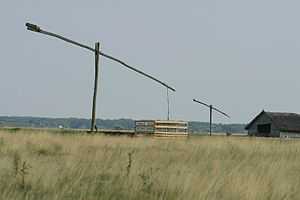Puszta

Puszta (Hungarian pronunciation: [ˈpustɒ]) is a grassland biome[1] on the Great Hungarian Plain (Alföld) around the River Tisza in the eastern part of Hungary as well as on the western part of Hungary and in the Austrian Burgenland. The Hungarian puszta is an exclave of the Eurasian Steppe.
It covers a total area of ca. 50,000 km2 (20,000 sq.mi). The characteristic landscape is composed of treeless plains, saline steppes and salt lakes, and includes scattered sand dunes, low, wet forests and freshwater marshes along the floodplains of the ancient rivers.[2]
Name
The word means "plains", a vast wilderness of grass and bushes. The name comes from an adjective of the same form, meaning "waste, barren, bare". Puszta is ultimately a Slavic loanword in Hungarian (compare Serbo-Croatian and Bulgarian pust and Polish pusty, both meaning bare or empty).
Climate
The climate is continental. Landscape is widely cultivated, the original Puszta landscape now being found only in a few places, for example in Hortobágy National Park.
Fauna
300 species of birds are found here.[2]
See also
External links
References
- ↑ Ward Chesworth, Encyclopedia of Soil Science, Springer, 2008, p. 66
- ↑ 2.0 2.1 Peter Haggett, Encyclopedia of World Geography: Eastern Europe, page 1781
Coordinates: 47°34′48″N 21°09′00″E / 47.58000°N 21.15000°E